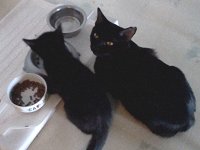Phosphorus and your cat's kidneys

After calcium, phosphorus is the most common mineral in a mammal's body. A healthy body needs phosphorus for, among others: strong bones and teeth, growing, maintaining, and repairing body tissue and cells, assistance in muscle contraction, reducing muscle pain after exercise, maintaining a regular heartbeat, good nerve conduction, managing how the body stores and uses energy.
Phosphorus also helps the kidneys to filter waste products from the bloodstream. In short without phosphorus no animal could survive, but there can be too much of a good thing. Scientific studies show that there are strong links between too much phosphorus and some diseases, especially those involving kidney damage.
Phosphates are naturally present in many foods including dairy products, meat and eggs. However, some foods also contain synthetic phosphates used as preservatives and flavour enhancers. These phosphates are routinely added to many processed foods - including cat foods.
The consumer organization Stiftung Warentest in Germany recently tested commercial cat foods. Their results revealed that most cat foods contain several times the amount of phosphorus required to keep cats healthy. This was particularly true with moist food formulations. One cat food contained nine times the amount of phosphorus that a healthy cat actually needs.
This is important because chronic kidney disease (CKD) is a major cause of death in cats. Almost 35% of elderly cats develop signs of CKD, and in most cases it is unclear why the disease developed. High levels of phosphates are now considered a likely part of the problem. It has already been known for some time that diet plays an important part in managing chronic renal failure in cats. New research has stressed the importance of reducing the amount of protein, phosphorus and sodium in the diet of CKD cats.*
[* e.g. Dietary management of feline chronic renal failure: where are we now? In what direction are we headed? published in 2000 in the Journal of Feline Medicine and Surgery, Polzinet al.]
But while it was known that lower phosphate levels help damaged kidneys to cope, until recently phosphate additives to cat food were considered harmless for cats with healthy kidneys. As a result most cat food labels simply say that phosphates have been added, without saying how much. However, a new study by veterinarians from Ludwig-Maximilians-Universitaet (LMU) in Munich shows that these phosphates might not be as safe as previously thought.
Their study showed that even with healthy cats a high phosphorus diet stresses kidney function within a few weeks. Thirteen healthy adult cats were fed a phosphorus-heavy diet (about five times more than their bodies needed), and these cats were compared with a control group of cats on a balanced diet.
The trial lasted for almost a month. To check how the kidneys were doing, urine and blood was collected from all cats. The scientists looked especially at glucose and proteins partly because higher levels of sugar in the urine are associated with diabetes and kidney disease. The cats with the high phosphorus diet quickly developed symptoms of glycosuria - a condition related to high sugar levels. Nine out of the thirteen cats with the high phosphorus diet also showed symptoms of a condition called microalbuminuria, which occurs when the kidneys are not working properly. No such problems were seen with the control group.
Another measure of a functioning kidney is the ability to handle creatinine (a waste product in the blood produced - for example - by strenuous exercise). How well a kidney filters this is called the 'creatinine clearance rate'. Cats with a high phosphorus diet had a poorer creatinine clearance rate than the control group, and their kidneys were also working harder to remove excess phosphorus from the body.
All this strongly suggests that there is a real connection between high levels of phosphorus - especially artificially added phosphorus - in food and negative changes in kidney function. With the young cats in this experiment, this had no lasting effect because their metabolisms returned to normal once they were taken off the high-phosphorus diet. However, if a cat spends years on a diet with excessive phosphorus - especially synthetic phosphorus - it is highly probable that this contributes to the irreversible kidney damage often seen in older cats.
What can you do? If you are worried that your cat may be getting too much phosphorus, the first thing is to talk to your vet and establish what a safe level looks like for your cat. (This varies according to size, age and activity levels.) Then, even if you don't strike your catís favourite dinner permanently from the menu, you might consider every now and then switching to a more natural alternative while your cat clears the excess from her system.
Journal Reference:
Britta Dobenecker, Anna Webel, Sven Reese, Ellen Kienzle. Effect of a high phosphorus diet on indicators of renal health in cats. Journal of Feline Medicine and Surgery (2017), vol 20(4), pp: 339-343.
The information supplied here is intended as a guideline only.
